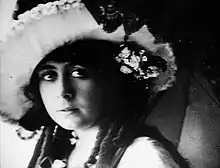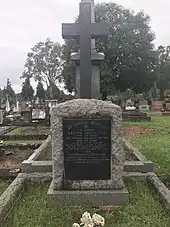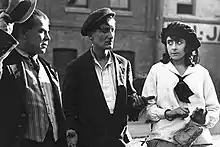Lottie Lyell | |
|---|---|
 Lottie Lyell, c. 1915 | |
| Born | Charlotte Edith Cox 23 February 1890 |
| Died | 21 December 1925 (aged 35) |
| Resting place | Macquarie Park Cemetery and Crematorium |
| Occupations |
|
| Years active | 1911–1925 |
| Partner | Raymond Longford (1912–1925) |
Lottie Lyell (born Charlotte Edith Cox, 23 February 1890 – 21 December 1925) was an Australian actress, screenwriter, editor and filmmaker. She is regarded as Australia's first film star,[1] and also contributed to the local industry during the silent era through her collaborations with director and writer Raymond Longford.
She was born in Balmain, a suburb in Sydney, New South Wales in 1890.[2] By 1912, Lyell had become romantically involved with Longford. The couple lived together in Brisbane and formed one of the most productive and influential partnerships in the history of Australian cinema. Although Longford was separated, his Catholic wife would not divorce him and he was never able to marry Lyell. Lyell fell ill with tuberculosis and died at her home in Roseville, North Sydney on 21 December 1925. Longford died in 1959, and is buried alongside Lyell at Macquarie Park Cemetery and Crematorium.
Career
Charlotte Cox started her acting career at the age of 17. She took the stage name of Lottie Lyell, and in 1910 at age 20 had her theatre breakthrough, when she performed as Maggie Brown in An Englishman's Home. The travelling theatre company took Lyell on tour for the show and she performed across Australia, including Tasmania, and New Zealand. After visiting 85 towns, the tour ended when a flood held up the production in Murtoa, Victoria. Lyell's later theatre successes continued when she joined the Clark and Meynell Company.
Raymond Longford

The following year, Lyell exchanged live theatre for a new, modern medium – film. She debuted in Alfred Rolfe's Captain Midnight, The Bush King and by late 1911 her lead role in Raymond Longford's The Romantic Story of Margaret Catchpole (1911) transformed her into Australia's first international film star. The British magazine Punch wrote of the film, "This big film is the best that has been made in Australia".
Lyell and Longford formed one of the most influential and pioneering partnerships in Australian film history. In 1913 Lyell starred in 'Neath Austral Skies as Eileen Delmont. Notably in this role she performed her own stunts, which included riding a horse with a knife between her teeth and diving into the sea. Another Longford/Lyell film made in 1913, Australia Calls, contained some 'special effects' such as cardboard planes flying down wires, annihilating some Sydney landmarks.
Although Longford offered to film battlefronts during the Great War from 1914 until 1918, the Australian Government declined his offer. Longford and Lyell would never make a war related feature during the First World War.

In 1919, Lyell portrayed Doreen in The Sentimental Bloke, which is now regarded as the landmark piece of the Longford/Lyell collaborations. Lyell is believed to have also contributed to the screenplay, art direction, editing and production. In 1921, Lyell wrote, edited and co-directed The Blue Mountains Mystery to much critical acclaim. Longford and Lyell formed Longford-Lyell Australian Motion Picture Productions in 1922. Lyell also returned to acting in 1922 with Rudd's New Selection.[3]
She was active until her death in 1925, and two of her screenplays, Peter Vernon's Silence and The Pioneers, were made into films the following year.
Final years
In the early 1920s, Lyell's health declined. Lyell's sister, Lynda Cox, died in September 1925.[4] Lottie Lyell died from tuberculosis on 21 December the same year and was buried at Macquarie Park Cemetery and Crematorium.[5] Raymond Longford died on 2 April 1959 and was buried beside her.
Filmography
Actress
- Captain Midnight, the Bush King (1911)
- Captain Starlight, or Gentleman of the Road (1911)
- The Fatal Wedding as Mabel Wilson (1911)
- The Life of Rufus Dawes (1911)
- The Romantic Story of Margaret Catchpole as Margaret Catchpole (1911)
- The Tide of Death as Sylvia Grey (1912)
- The Midnight Wedding as Princess Astrea (1912)
- Australia Calls as Beatrice Evans (1913)
- Pommy Arrives in Australia or Pommy, the Funny Little New Chum (Australia) (1913)
- 'Neath Austral Skies as Eileen Delmont (1913)
- Trooper Campbell (1914) – short
- The Swagman's Story (1914) – short
- Taking his Chance (1914) – short
- The Silence of Dean Maitland as Marion, Henry's sister (1914)
- We'll Take her Children in amongst our own (1915)
- A Maori Maid's Love (1916)
- The Mutiny of the Bounty as Nessy Heywood (1916)
- The Church and the Woman as Eileen Shannon (1917)
- The Woman Suffers as Marjory Manton (1918)
- The Sentimental Bloke as Doreen (1919)
- Ginger Mick reprising her role as Doreen (1920)
- Rudd's New Selection as Nell Garvin (1921)
- The Dinkum Bloke reprising her role as Nell Garvin (1923)
- An Australian by Marriage (1923)
Writer
- Australia Calls (1913)
- The Mutiny of the Bounty (1916)
- The Sentimental Bloke (1919)
- On Our Selection (1920)
- Ginger Mick (1920)
- Rudd's New Selection (1921)
- The Blue Mountains Mystery (1921)
- The Dinkum Bloke (1923)
- Australia Calls (1923)
- The Bushwhackers (1925)
- The Pioneers (1926)
- Sons of Australia, screened as Peter Vernon's Silence (1926)
Editor
- The Mutiny of the Bounty (1916)
- The Sentimental Bloke (1919)
Producer
- The Dinkum Bloke (1923)
Assistant director
- The Dinkum Bloke (1923)
Director
- The Blue Mountains Mystery (1921)
Theatre credits
- The Land of Gold by George Darrell (1907)[6]
- vaudeville (1908)[7]
- Geach touring company (1909)[8]
- An Englishman's Home (1909)[9]
- The Midnight Wedding (1910) – tour[10]
- Why Men Love Women by Walter Howard (1910)[11]
- The Fatal Wedding (1910) – tour with Raymond Longford and Gilbert Emery[12]
- Her love against the world
References
- ↑ Lottie Lyell at IMDb
- ↑ National Film & Sound Archive, Photo Play Artiste of Lottie Lyell by Marilyn Dooley Archived 29 September 2009 at the Wayback Machine
- ↑ Vagg, Stephen (18 August 2019). "Australian Movie Stars". Filmink.
- ↑ "Family Notices". The Sydney Morning Herald. National Library of Australia. 29 September 1925. p. 10. Retrieved 29 August 2013.
- ↑ "Family Notices". The Sydney Morning Herald. National Library of Australia. 23 December 1925. p. 11. Retrieved 29 August 2013.
- ↑ "Advertising". The Sydney Morning Herald. National Library of Australia. 23 November 1907. p. 2. Retrieved 29 August 2013.
- ↑ "Advertising". The Sydney Morning Herald. National Library of Australia. 18 March 1908. p. 2. Retrieved 29 August 2013.
- ↑ "THE STRUTTER'S PAGE". The Newsletter: an Australian Paper for Australian People. Sydney: National Library of Australia. 19 June 1909. p. 3. Retrieved 29 August 2013.
- ↑ ""AN ENGLISHMAN'S HOME."". The Dubbo Liberal and Macquarie Advocate. NSW: National Library of Australia. 10 July 1909. p. 3. Retrieved 29 August 2013.
- ↑ ""THE MIDNIGHT WEDDING."". The Singleton Argus. NSW: National Library of Australia. 10 March 1910. p. 3. Retrieved 29 August 2013.
- ↑ "AMUSEMENTS". Maitland Daily Mercury. NSW: National Library of Australia. 14 March 1910. p. 2. Retrieved 29 August 2013.
- ↑ ""THE FATAL WEDDING."". The Singleton Argus. NSW: National Library of Australia. 12 July 1910. p. 2. Retrieved 29 August 2013.
Resources
- Shirley, Graham; Adams, Brian (1983). Australian Cinema: The First 80 Years. Angus & Robertson Publishers. ISBN 0-207-14581-4.
External links
- Lottie Lyell at Trove
- Lottie Lyell at Australian Dictionary of Biography
- Lyell, Lottie Edith (1890–1925) at The Encyclopedia of Women and Leadership in Twentieth-Century Australia